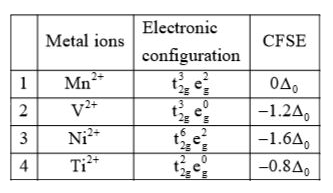[Co(H2O)6]3+ complex is
a.High spin complex
b.Having d2sp3-hybridization
c.Low spin complex
d.Having octahedral structure .
The correct Answer is:B, C, D
To analyze the complex (Co(H₂O)₆)³⁺, we will follow these steps:
Step 1: Determine the oxidation state of cobalt.
The complex is (Co(H₂O)₆)³⁺. Since water (H₂O) is a neutral ligand, it does not contribute to the oxidation state. Therefore, we can set up the equation:
\(
\text{Oxidation state of Co} + 0 = +3
\)
This implies that the oxidation state of cobalt (Co) is +3.
Step 2: Write the electronic configuration of cobalt in the +3 oxidation state.
The atomic number of cobalt (Co) is 27. The ground state electronic configuration of cobalt is:
\(
\text{Co: } (Ar) 3d^7 4s^2
\)
When cobalt is in the +3 oxidation state, it loses three electrons (two from 4s and one from 3d), resulting in:
\(
\text{Co}^{3+}: (Ar) 3d^6
\)
Step 3: Analyze the ligand and its field strength.
The ligand in this complex is H₂O, which is generally considered a weak field ligand. However, in the case of cobalt in the +3 oxidation state, H₂O behaves as a strong field ligand. Strong field ligands tend to cause pairing of electrons in the lower energy d orbitals.
Step 4: Fill the d orbitals.
For the 3d⁶ configuration, we fill the d orbitals considering that H₂O is a strong field ligand, leading to pairing of electrons:
1. The first two electrons will occupy the first d orbital (pairing).
2. The next two electrons will occupy the second d orbital (pairing).
3. The last two electrons will occupy the third d orbital (pairing).
The resulting configuration will be:
\(
\text{3d: } \uparrow\downarrow \, \uparrow\downarrow \, \uparrow\downarrow
\)
This indicates that all six electrons are paired, confirming that it is a low spin complex.
Step 5: Determine the hybridization.
For a coordination number of 6, the hybridization involves two d orbitals, one s orbital, and three p orbitals:
\(
\text{Hybridization: } d^2sp^3
\)
Step 6: Identify the geometry of the complex.
With a coordination number of 6 and d²sp³ hybridization, the geometry of the complex is octahedral.
Conclusion:
The complex (Co(H₂O)₆)³⁺ is a low spin complex with d²sp³ hybridization and has an octahedral structure.
Summary of Findings:
- Oxidation state of Co: +3
- Electronic configuration: 3d⁶
- Type of complex: Low spin
- Hybridization: d²sp³
- Geometry: Octahedral
The complex is (Co(H₂O)₆)³⁺. Since water (H₂O) is a neutral ligand, it does not contribute to the oxidation state. Therefore, we can set up the equation:
\text{Oxidation state of Co} + 0 = +3
\)
The atomic number of cobalt (Co) is 27. The ground state electronic configuration of cobalt is:
\text{Co: } (Ar) 3d^7 4s^2
\)
\text{Co}^{3+}: (Ar) 3d^6
\)
The ligand in this complex is H₂O, which is generally considered a weak field ligand. However, in the case of cobalt in the +3 oxidation state, H₂O behaves as a strong field ligand. Strong field ligands tend to cause pairing of electrons in the lower energy d orbitals.
For the 3d⁶ configuration, we fill the d orbitals considering that H₂O is a strong field ligand, leading to pairing of electrons:
2. The next two electrons will occupy the second d orbital (pairing).
3. The last two electrons will occupy the third d orbital (pairing).
\text{3d: } \uparrow\downarrow \, \uparrow\downarrow \, \uparrow\downarrow
\)
For a coordination number of 6, the hybridization involves two d orbitals, one s orbital, and three p orbitals:
\text{Hybridization: } d^2sp^3
\)
With a coordination number of 6 and d²sp³ hybridization, the geometry of the complex is octahedral.
The complex (Co(H₂O)₆)³⁺ is a low spin complex with d²sp³ hybridization and has an octahedral structure.
- Oxidation state of Co: +3
- Electronic configuration: 3d⁶
- Type of complex: Low spin
- Hybridization: d²sp³
- Geometry: Octahedral
Topper's Solved these Questions
- COORDINATION COMPOUNDSBOOK - CENGAGE CHEMISTRY ENGLISHCHAPTER - COORDINATION COMPOUNDSEXERCISE - Exercises Multiple Correct(Application Of Coordination Compounds)
8 Videos
- COORDINATION COMPOUNDSBOOK - CENGAGE CHEMISTRY ENGLISHCHAPTER - COORDINATION COMPOUNDSEXERCISE - Exercises Single Correct (Naming And Terminology)
30 Videos
- COORDINATION COMPOUNDSBOOK - CENGAGE CHEMISTRY ENGLISHCHAPTER - COORDINATION COMPOUNDSEXERCISE - Exercises Multiple Correct(Isomerism )
10 Videos
- CHEMICAL KINETICSBOOK - CENGAGE CHEMISTRY ENGLISHCHAPTER - CHEMICAL KINETICSEXERCISE - Archives Subjective
23 Videos
- D AND F BLOCK ELEMENTSBOOK - CENGAGE CHEMISTRY ENGLISHCHAPTER - D AND F BLOCK ELEMENTSEXERCISE - Archives Subjective
29 Videos
Similar Questions
Knowledge Check
Which of the following statements is correct about [Co(H2O)6]2+ complex ?
AElectronic configuration = 3d7→t52ge2g ,
no. of unpaired electrons = 3,μ=3.87B.MBElectronic configuration = 3d6→t42ge2g .
no. of unpaired electrons = 2 , μ=2.87B.MCElectronic configuration = 3d7→t62ge1g .
no. of unpaired electrons = 1 , μ=2.87B.MDElectronic configuration = 3d7→t32ge4g .
no. of unpaired electrons = 3 , μ=3.87B.MUsing valence bond theory , the complex [Cr(H2O)6]3+ can be described as
Asp3d2 , outer orbital complex , paramagneticBdsp2 , inner orbital complex , diamagneticCd2sp3 , inner orbital complex , paramagneticDd2sp3 , outer orbital complex , diamagnetic .
[Sc(H2O)6]3+ ion is :-
View SolutionExplain the violet colour of the complex [Ti(H2O)6]3+ on the basis of crystal field theory.
View SolutionAssertion: [Ti(H2O)6]4+ is coloured while [Sc(H2O)6]3+ is colourless.
Reason: d-d transition is not possible in [Sc(H2O)6]3+.
View SolutionA: [Cr(H2O)6]3+ is Inner orbital complex.
R: H2O is strong ligand generally
View SolutionThe absorption maxima of several octahedral complex ions are as follows:
S.NoCompoundλmaxnm1[Co(NH3)6]3+4752[Co(CN)6]3−3103[Co(H2O)6]3+490
The crystal field SQPlitting is maximum for :
View SolutionClassify each of the following complexes as either high or low spin . Explain your answers.
(i) [Co(H2O)6]2+μ=3.87B.M. [Co(CN)6]3−μ=0.0B.M.
(ii) [Fe(NO2)6]4−μ=0.0B.M. [Fe(H2O)6]3+μ=5.94B.M.
View Solution

